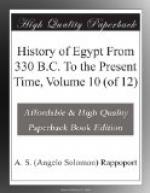The black spot upon the character of Philadelphus, which all the blaze of science and letters by which he was surrounded can not make us overlook, is the death of two of his brothers: a son of Eurydice, who might, perhaps, have thought that he was robbed of the throne of Egypt by his younger brother, and who was unsuccessful in raising the island of Cyprus in rebellion; and a younger brother, Argasus, who was also charged with joining in a plot; both lost their lives by his orders.
It was only in the beginning of this reign, after Egypt had been for more than fifty years under the rule of the Macedonians, that the evils which often follow conquest were brought to an end. Before this reign no Greek was ever known to have reached Elephantine and Syene or Aswan since Herodotus made his hasty tour in the Thebaid; and during much of the last reign no part of Upper Egypt was safe for a Greek traveller, if he were alone, or if he quitted the highroad. The peasants, whose feelings of hatred we can hardly wonder at, waylaid the stragglers, and Egyptian-like as the Greeks said, or slave-like as it would be wiser to say, often put them to death in cold blood. But a long course of good government had at last quieted the whole country, and left room for further improvements by Philadelphus.
Among other buildings, Philadelphus raised a temple in Alexandria to the honour of his father and mother, and placed in it their statues, made of ivory and gold, and ordered that they should be worshipped like the gods and other kings of the country. He also built a temple to Ceres and Proserpine, and then the Eleusinian mysteries were taught in Alexandria to the few who were willing and worthy to be admitted. The southeast quarter of the city in which this temple stood was called the Eleusinis; and here the troop of maidens were to be seen carrying the sacred basket through the streets, and singing hymns in honour of the goddess; while they charged all profane persons, who met the procession, to keep their eyes upon the ground, lest they should see the basket and the priestesses, who were too pure for them to look upon.
In this reign was finished the lighthouse on the island of Pharos, as a guide to ships when entering the harbour of Alexandria by night. The navigation of the waters of the Red Sea, along which the wind blows hard from the north for nine months in the year, was found so dangerous by the little vessels from the south of Arabia, that they always chose the most southerly port in which they could meet the Egyptian buyers. The merchants with their bales of goods found a journey on camels through the desert, where the path is marked only by the skeletons of the animals that have died upon the route, less costly than a coasting voyage. Hence, when Philadelphus had made the whole of Upper Egypt to the cataracts at Aswan (Syene) as quiet and safe as the Delta, he made a new port on the rocky coast of the Red Sea, nearly two hundred miles to




